There in your bathroom where there was a walled system, or an unused vacuum good only for collecting dust, here is a niche. A small room dug into the wall support. It seems to be almost nothing, but immediately feel that the environment acquires an elegance, an almost mystical composure. More and more often in modern bathrooms you find these very useful gimmicks to enhance a wall and save space.
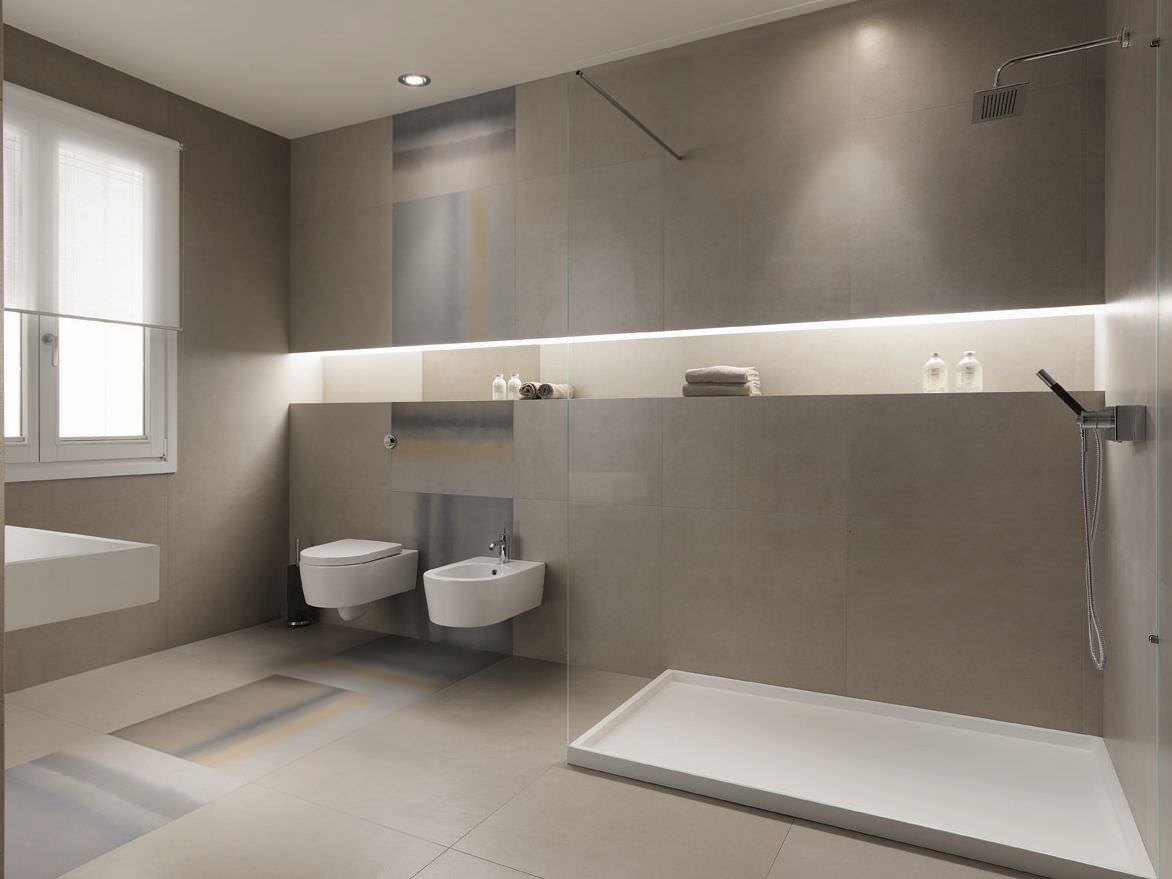
Look at this bathroom with an essential design. What does your gaze fall on? Certainly the first on the niche, which with its depth contributes greatly to qualifying not only the wall, but all the bathroom space.
The use of niches in architecture deserves a real treatise. You will all have in mind how these voids embellish small and large spaces in the history of architecture, with statues, fountains and other works of art. From churches to noble palaces, from spas to the humblest houses. The niche is a universal, practical and beautiful element. At any scale. So why not use it in your bathroom? In your raids on Pinterest you will surely have noticed how their presence attracts the eye. Very true, for the simple fact that their concavity communicates welcome, and our gaze likes the warmth of the welcome.
The bathroom is also an ideal environment for niches. Because? Because we will have many small items to fix. So many necessary objects such as creams, soaps, towels, toilet paper, brushes, razors, toothbrushes etc ... whose chaotic presence risks ruining an accurate project. Especially if you love minimal design, or if nothing else, the clean and tidy lines that prevail in modern bathrooms.
The niche is a perfect trick to hide and keep your furnishings at the same time. And if a piece of furniture occupies a certain volume, the niche, being built in, will also save you space. Here is its most basic and indispensable practical and aesthetic value.
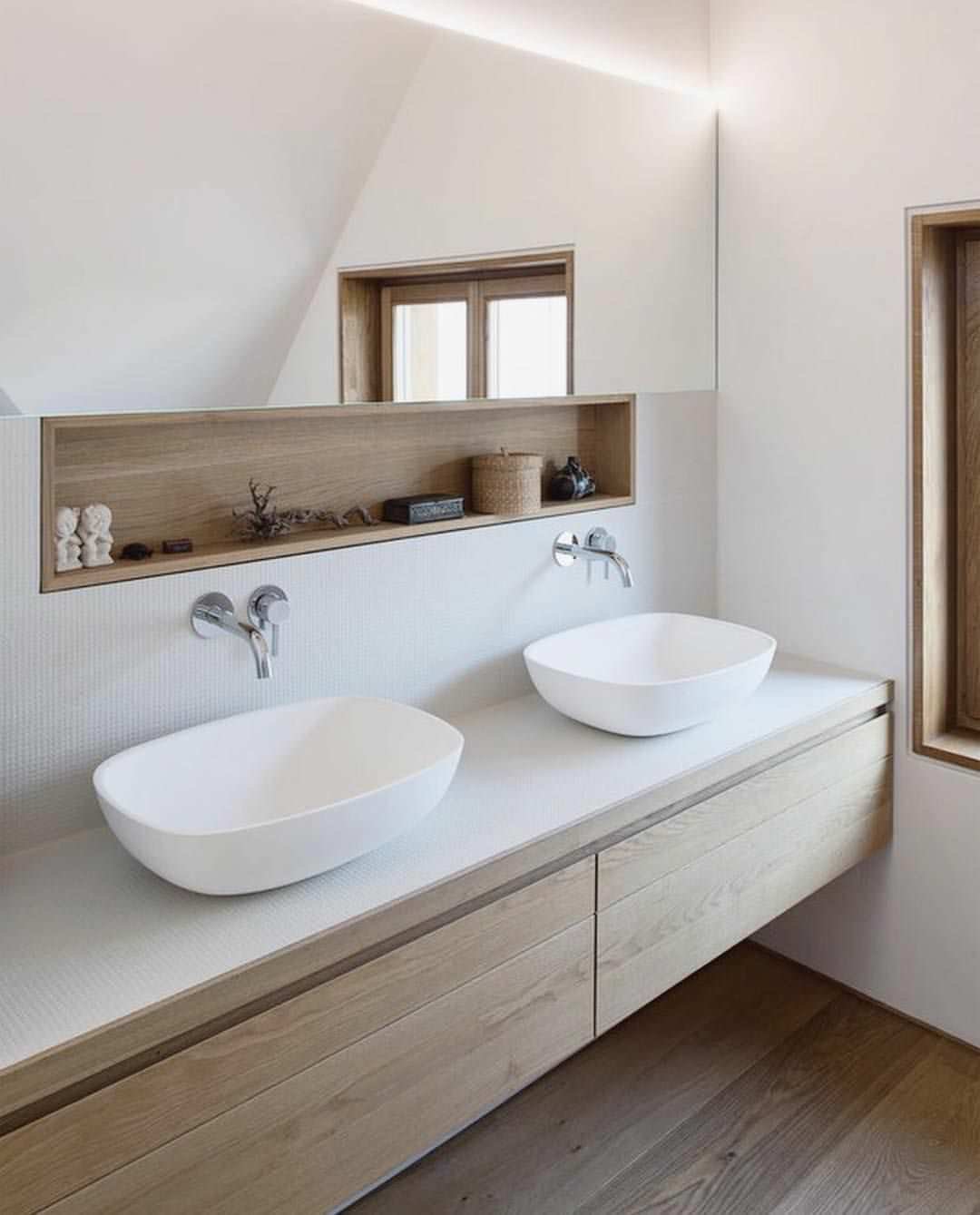
The bathroom is the ideal environment to create niches for another reason too. The presence of the plants. The majority of the wall thicknesses are increased to house the pipes, which however flow only in certain points. The rest of the surface can therefore be easily excavated to house the niches.
As always, piercing a wall is an operation to be entrusted to a professional. Primarily for the need not to damage the systems, or to not reduce too much the section of load-bearing wall elements. The punching must also be performed in a workmanlike manner, well shaped according to the shape you prefer: with a curved back wall perhaps, or topped by an arch. This is an operation that requires the use of special and highly detailed profiles. So, unless you are well trained, once again do-it-yourself: false hope of saving that will ultimately take you more money and more time.
Obviously working on an existing element is not the only solution. If you are in love with niches, you can create them ad hoc with the help of extra plasterboard thicknesses: in this case, contact a plasterboardist .
Or, as it is easy to imagine, the solution of the niches is well suited to masonry bathrooms, where the non-load-bearing profiles abound, which can be suitably pierced to compensate for the function of the furniture. If the realization is an operation by masons or plasterboard workers, the arrangement of the niches in the space is for interior designers. As said, a void will magnetize the look: better to arrange these spaces with absolute care. Our eye, which always tends to laziness, will be more inclined to position them centrally, or according to symmetries. But often this trend will lead you to trivial, not to say unpleasant solutions. The trained eye of the interior architect will instead help you find the most unexpected and surprising locations. He will also be able to indicate the most suitable materials to make these elements perfect. Better tone on tone, or with contrasting materials? With a frame that highlights the protrusion or flush, in perfect minimal style?
Since what is beautiful should not be hidden, a fundamental theme to enhance the design of niches is that of light. In itself a recess creates a shadow and the shadow arouses curiosity, accentuates the idea of a cave that attracts our unconscious gaze. But the light embellishes and warms. That's why most designers use led lighting for niches, grazing or rain, to make these empty spaces magnificent. Playing with shadows, a wall furrowed by niches can create a fascinating sculptural effect.
The niches, then, must not be rectangular. Elegant arched niches refer to the traditional solution. But any geometric shape is possible: think of solutions for attic spaces, which follow the sloping profile of the pitches. Or, very impressive and increasingly adopted, very thin and horizontal niches that run along an entire wall, often above the bathtub: they constitute in themselves a decoration and will allow you to place soaps and towels.
It is also possible to close the niche with doors, like any cabinet. The possibility must be examined from case to case, but it certainly seems contradictory to hide a virtually so intriguing solution. Rather, to further multiply the space, you can create shelves in wood, or glass, on which to place all the objects. Or why not aim high and place only one sculpture in the niche? A small antique-style statue will give you the impression of a precious spa space. In any case, whatever shape they have, the niches will allow you to create a fluid environment, reducing the masses protruding from the walls. A true paradise for lovers of minimal style. As well as savings on furniture.
A very frequent pairing is with concrete masonry, given the total shapeability of this material. A spatulated concrete niche will create a very modern industrial image, with a brutalist design, which will impress you with its unique character.
In short, your bathroom deserves a precious, useful, beautiful element, which recalls tradition but which blends perfectly with modern materials.
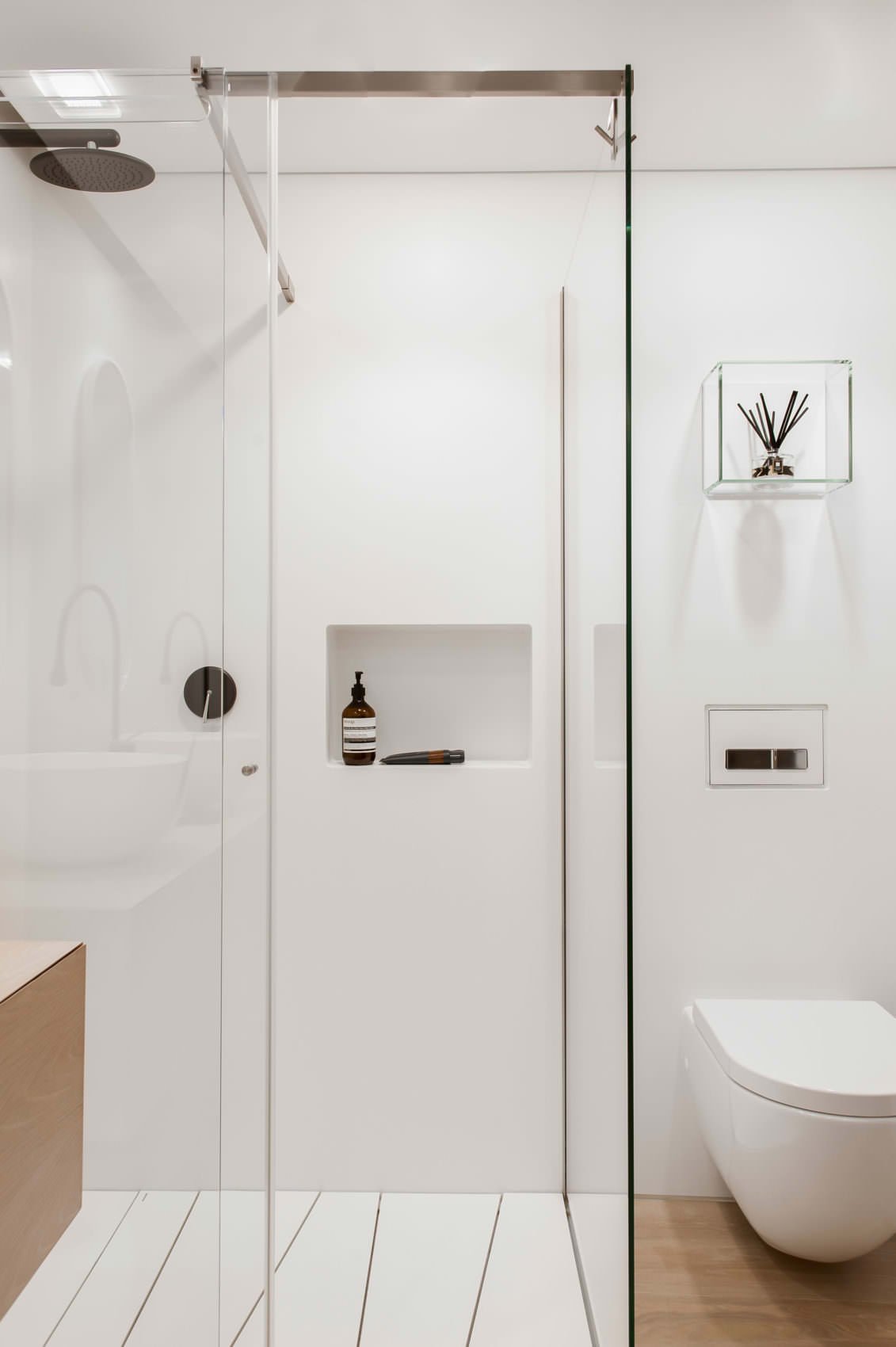
An almost imperceptible niche, perfect in a minimal style bathroom. Simply plastered, with a slightly rounded edge, it gives the entire wall a buttery tactile consistency. A small element that transfigures the whole environment.
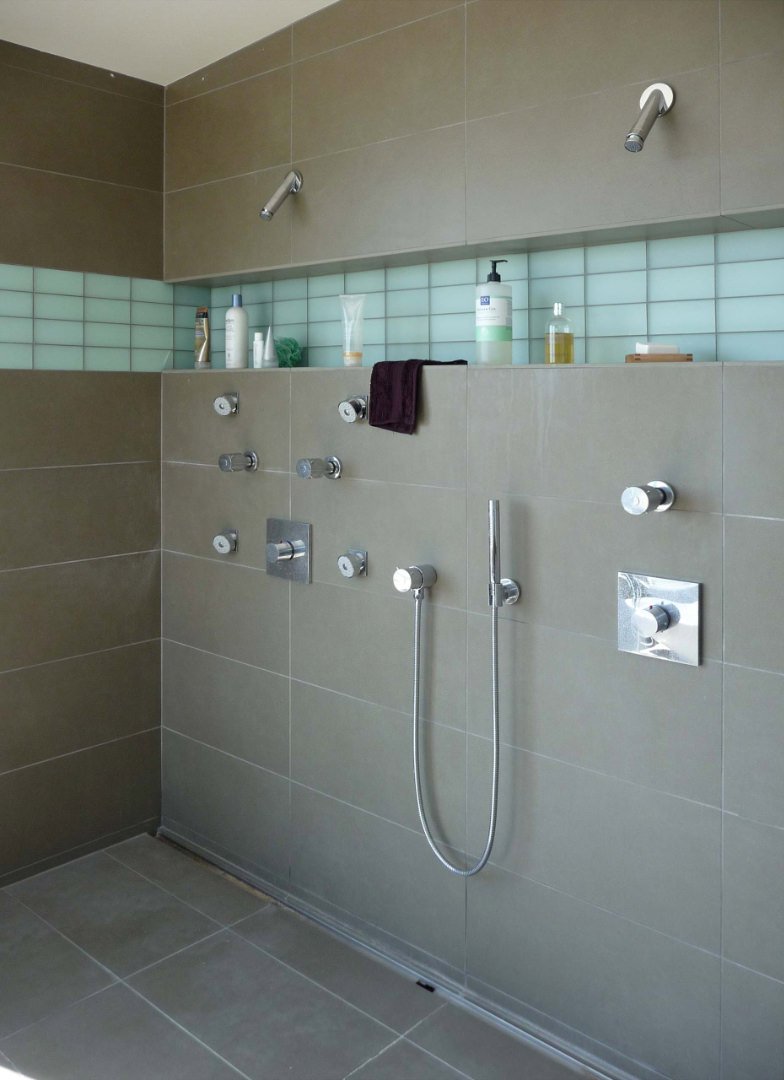
An important fact: the height of the niche. In this large stoneware shower, the horizontal niche is at head height, creating a particular visual effect that contains the height of the compartment.

A long and functional niche, perfectly centered with the shower mixer, covered in white resin, like the walls. Modern minimal style.
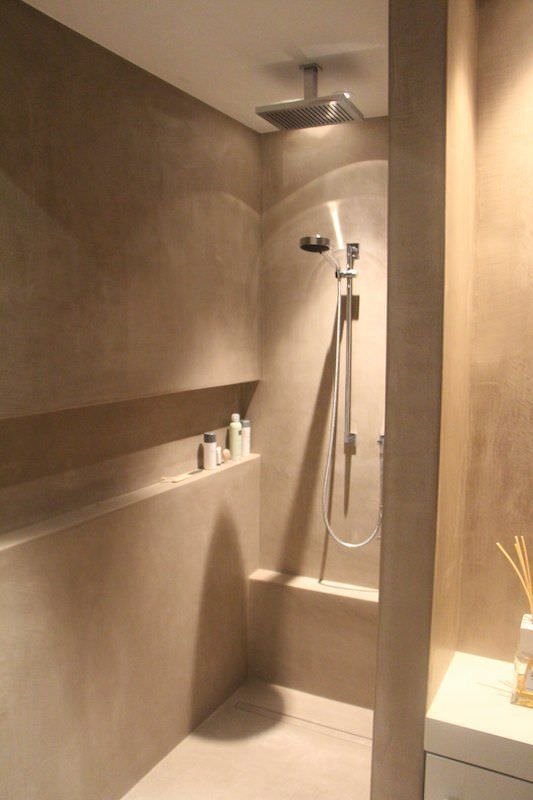
Masonry bathroom, covered in resin, with long niche made in the shower, useful and functional.
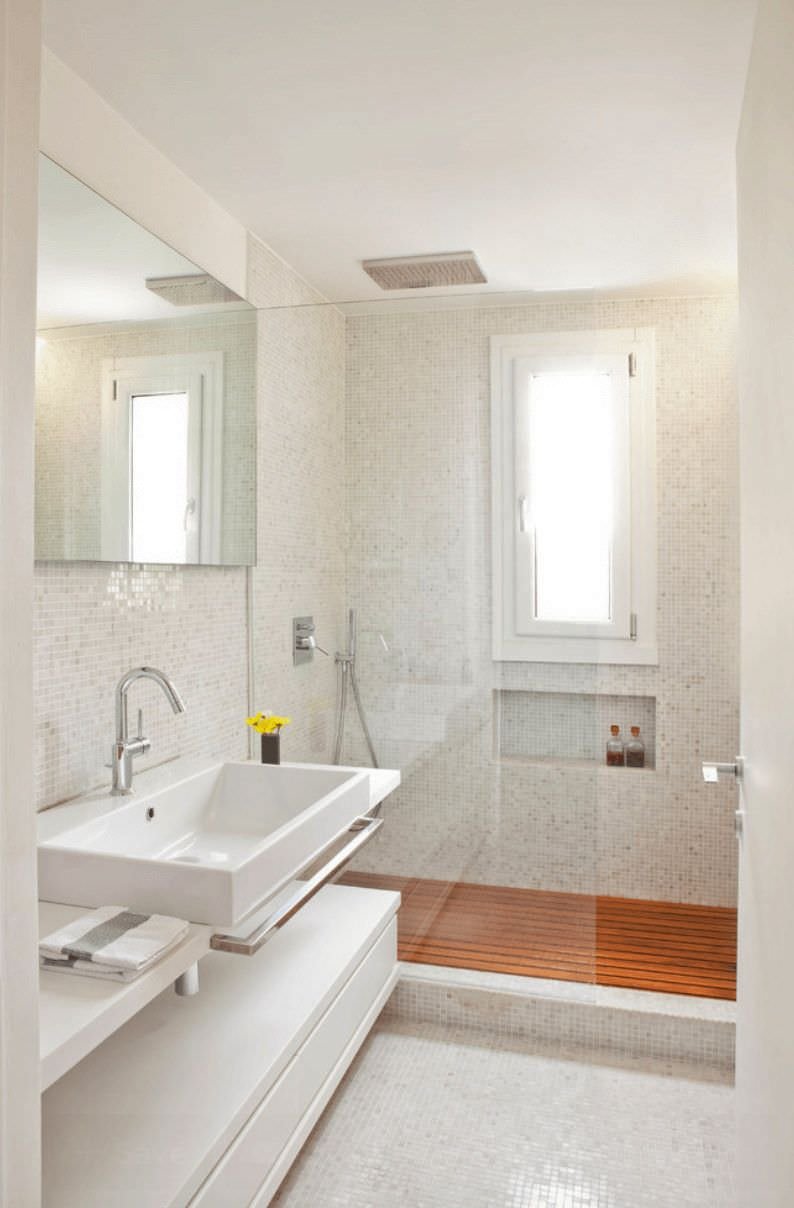
This niche, even if it is not in the "perfect" position, is a very useful space for putting soaps, bottles and small useful accessories in the shower.

Very interesting design idea for these two niches created on the sides of the vertical band, created in mosaic, which houses the shower head.
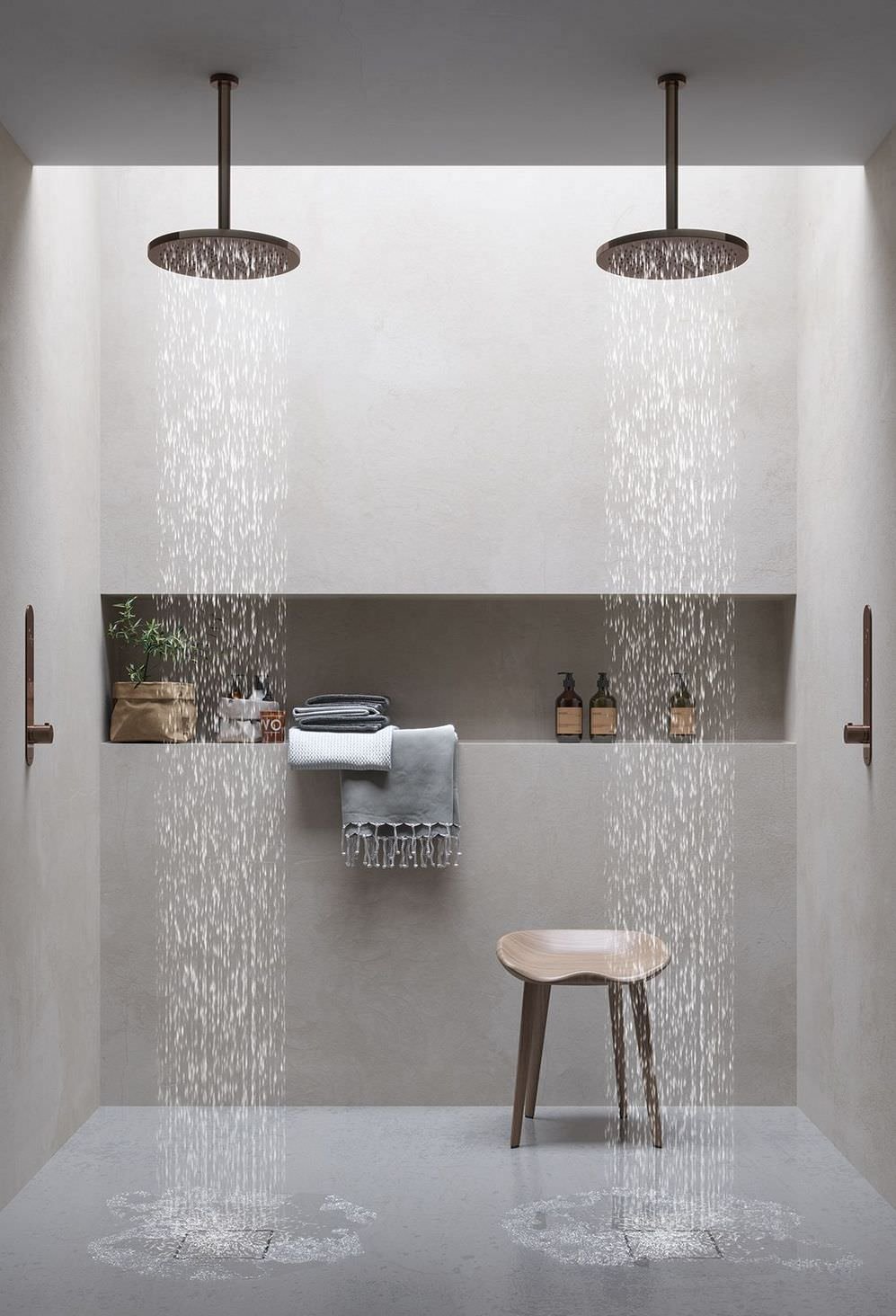
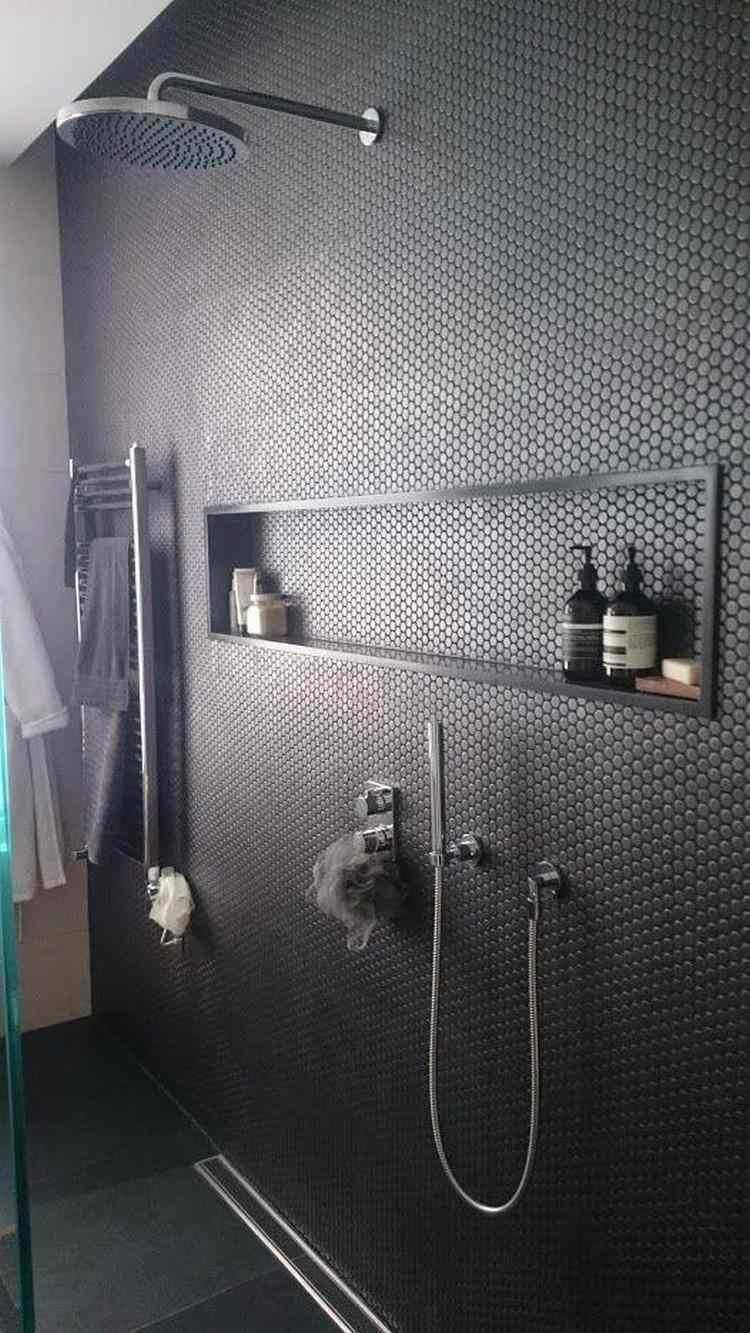
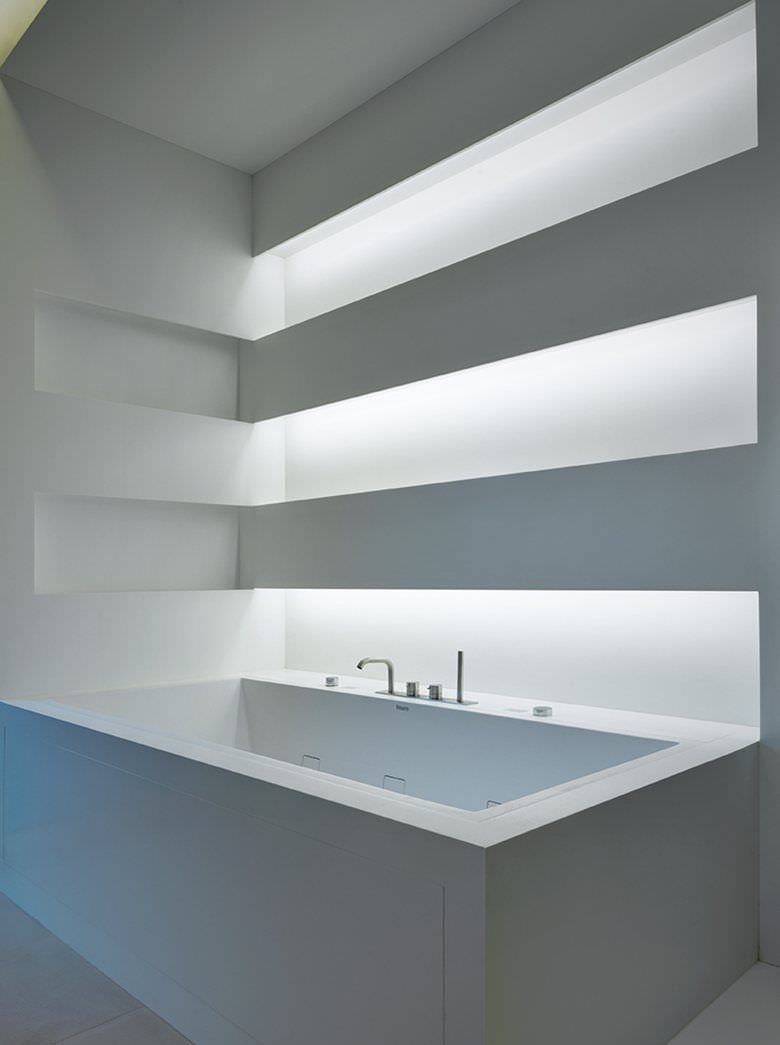
A traditional device, but which can become an excuse for a modern design. The niche is a subtraction of matter, which qualifies the wall giving it sculptural value. The lighting creates an original and scenographic environment.

A perfect example to visually enlarge a small bathroom. The niches that run horizontally along the length of the wall with an accent of color or pattern, in addition to maximizing storage space, tend to enlarge the room.
 The resin lends itself perfectly to covering walls with various niches. Next to a bathtub, a masonry wall allows you to create magnificent smooth and delicately colored surfaces with very soft natural tones. Depending on the pigments, beautiful natural shades can be obtained, from white to slate gray, or even ocher yellow.
The resin lends itself perfectly to covering walls with various niches. Next to a bathtub, a masonry wall allows you to create magnificent smooth and delicately colored surfaces with very soft natural tones. Depending on the pigments, beautiful natural shades can be obtained, from white to slate gray, or even ocher yellow.
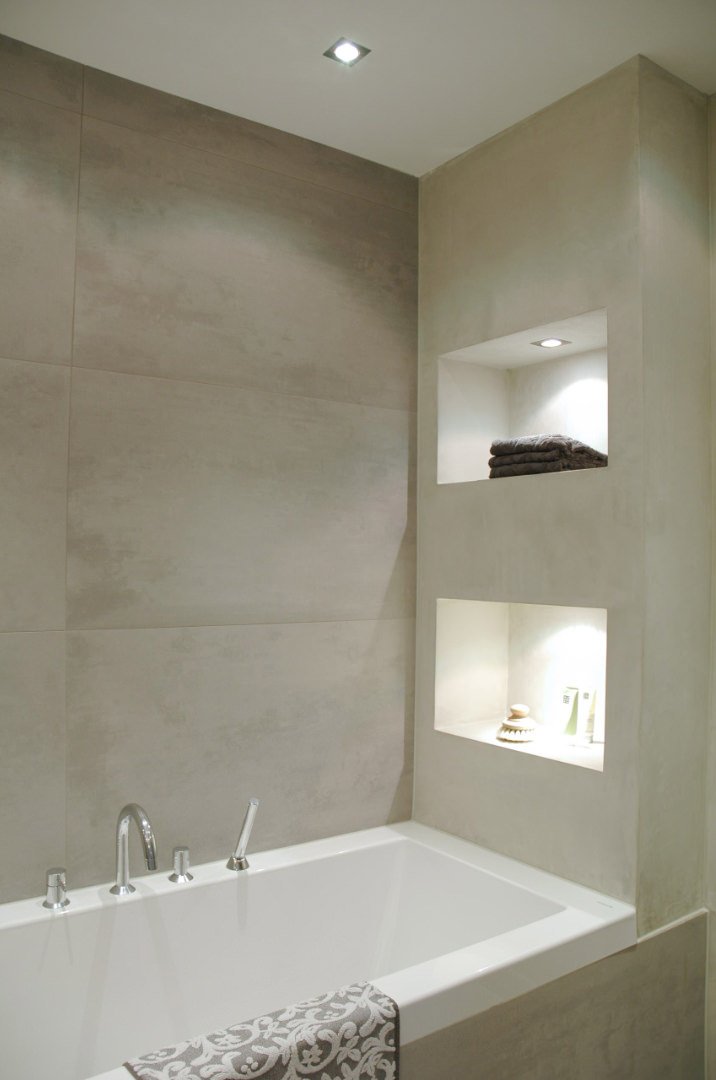 In the space between the wall and the tank, very useful niches can be obtained. If space permits, electrical cables can also be prepared to create illuminated niches, perfect for a relaxing bath.
In the space between the wall and the tank, very useful niches can be obtained. If space permits, electrical cables can also be prepared to create illuminated niches, perfect for a relaxing bath.
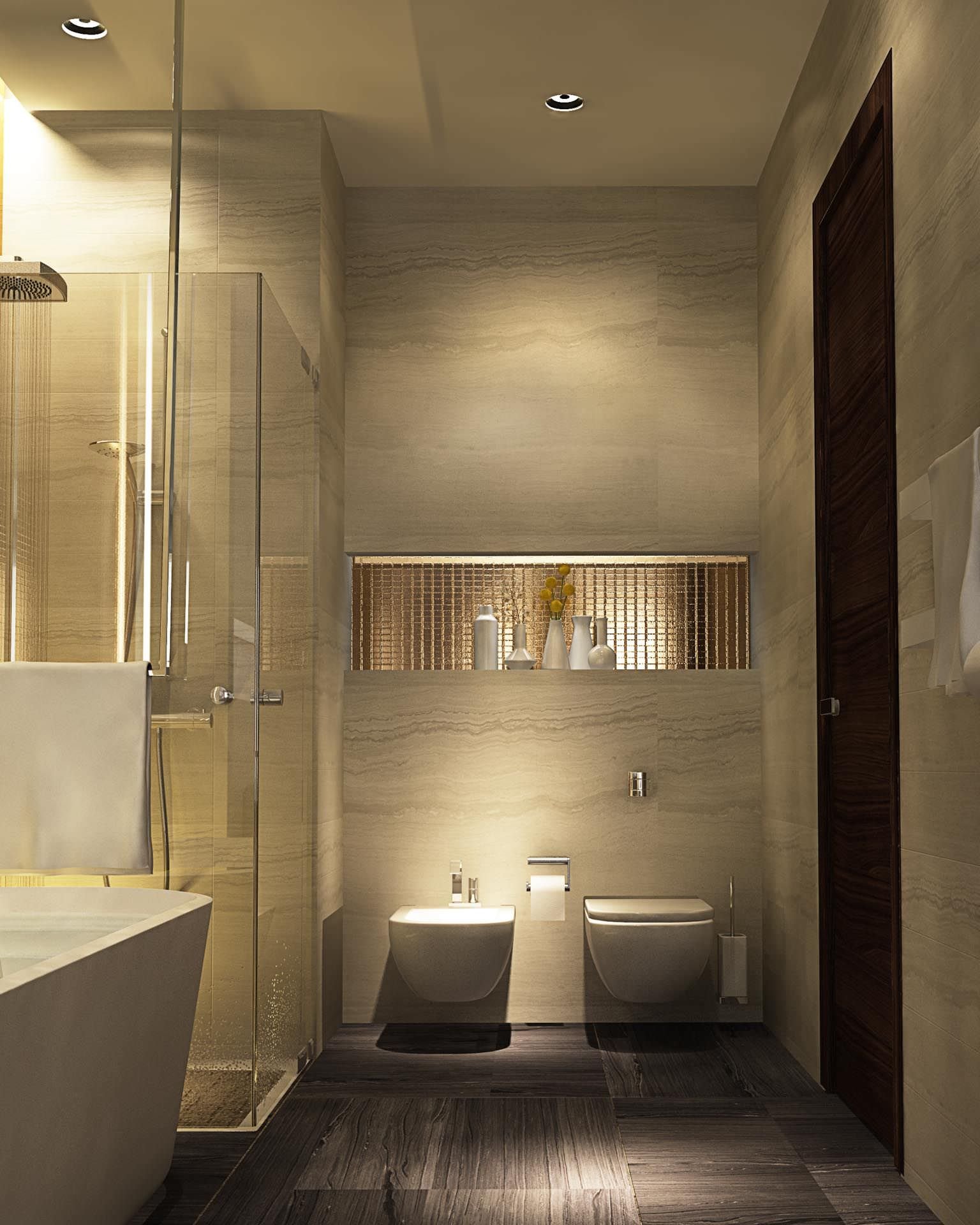 The niches embellish the objects they welcome. In this case, the soap dishes become almost a still life, against the precious background of a golden mosaic in perfect contrast with the stone walls.
The niches embellish the objects they welcome. In this case, the soap dishes become almost a still life, against the precious background of a golden mosaic in perfect contrast with the stone walls.
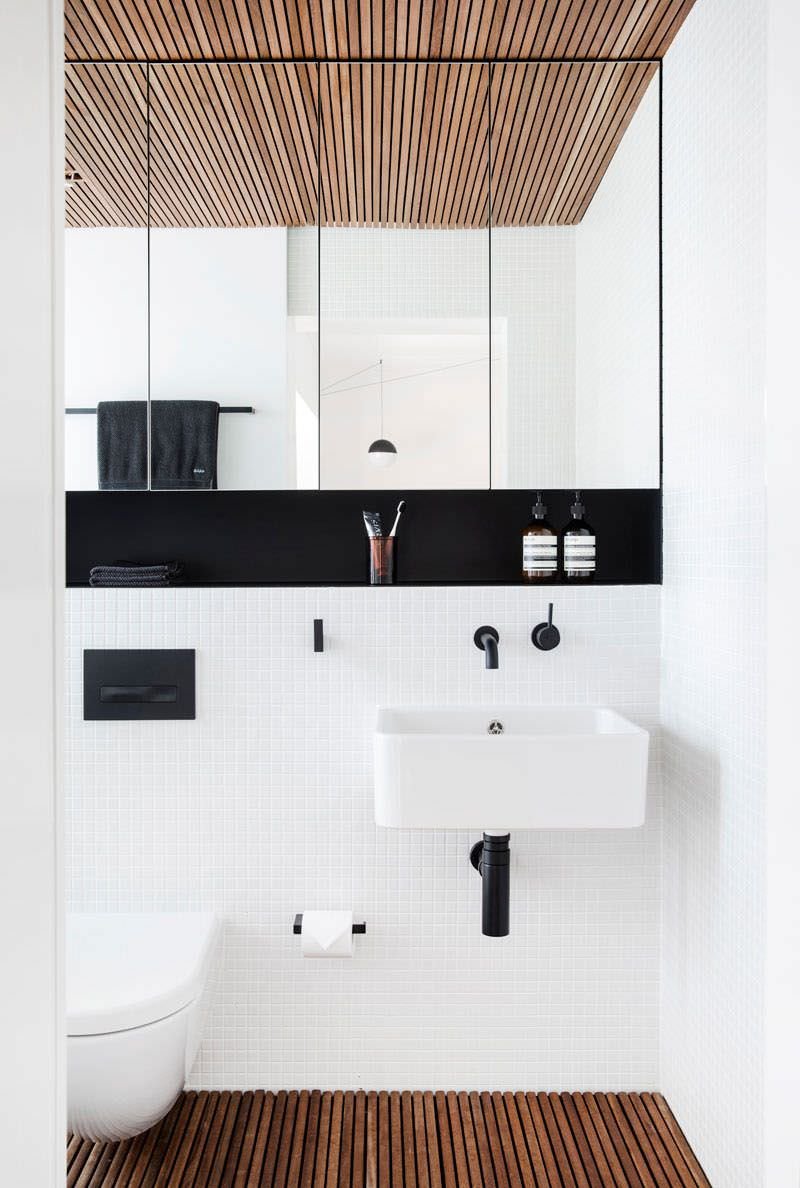 The niche is visually a shadow: in this case the idea of emptiness is interpreted with a black surface, in a beautiful and simple contrast with the white of the walls and sanitary ware.
The niche is visually a shadow: in this case the idea of emptiness is interpreted with a black surface, in a beautiful and simple contrast with the white of the walls and sanitary ware.
 A typical space for niches is above the toilet cistern, often embedded in the wall with loss of space ... recovered with the niche. Here it is enhanced by three decorative elements and by the sloping light.
A typical space for niches is above the toilet cistern, often embedded in the wall with loss of space ... recovered with the niche. Here it is enhanced by three decorative elements and by the sloping light.
 In this small bathroom, the niche created above the toilet cistern becomes a frame that takes on a decorative role, giving value and depth to the space. An alternative idea would be to insert doors, creating a very useful cabinet.
In this small bathroom, the niche created above the toilet cistern becomes a frame that takes on a decorative role, giving value and depth to the space. An alternative idea would be to insert doors, creating a very useful cabinet.
 As in the previous image, the toilet cistern creates a ledge that can be exploited, giving it utility. In this case, the niches were created vertically, next to the box, while the space above plays only a decorative role.
As in the previous image, the toilet cistern creates a ledge that can be exploited, giving it utility. In this case, the niches were created vertically, next to the box, while the space above plays only a decorative role.

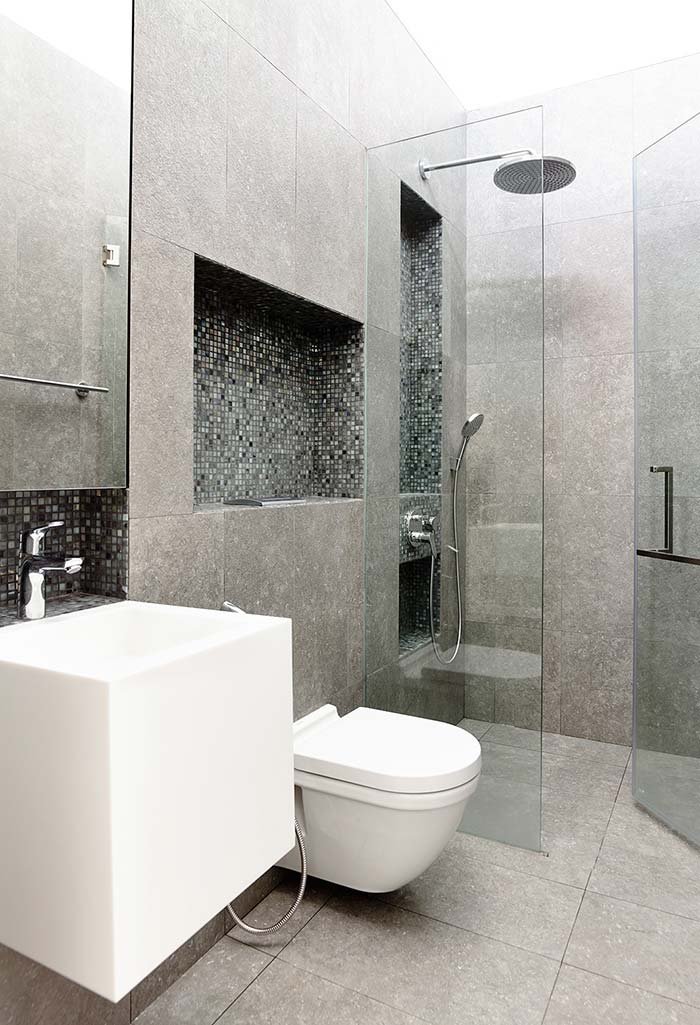
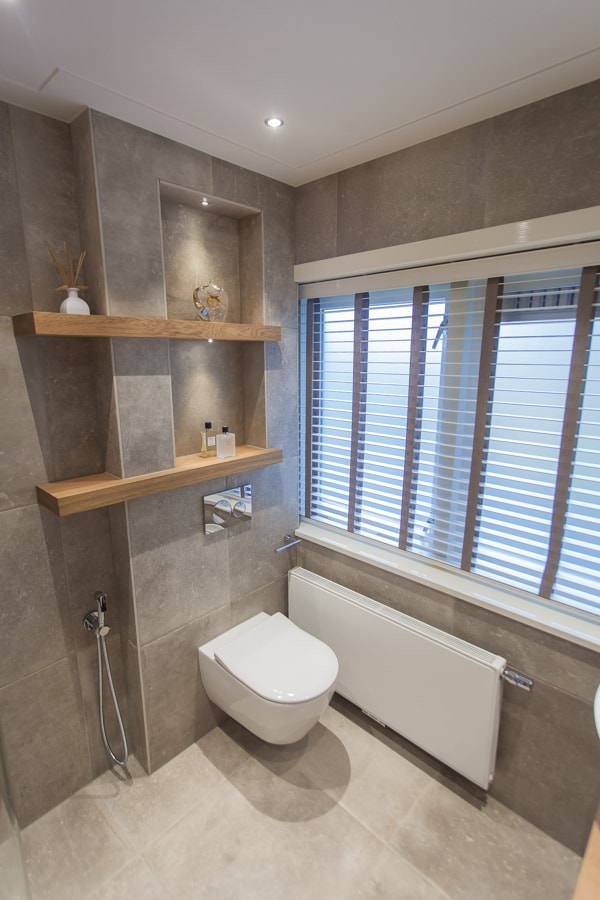
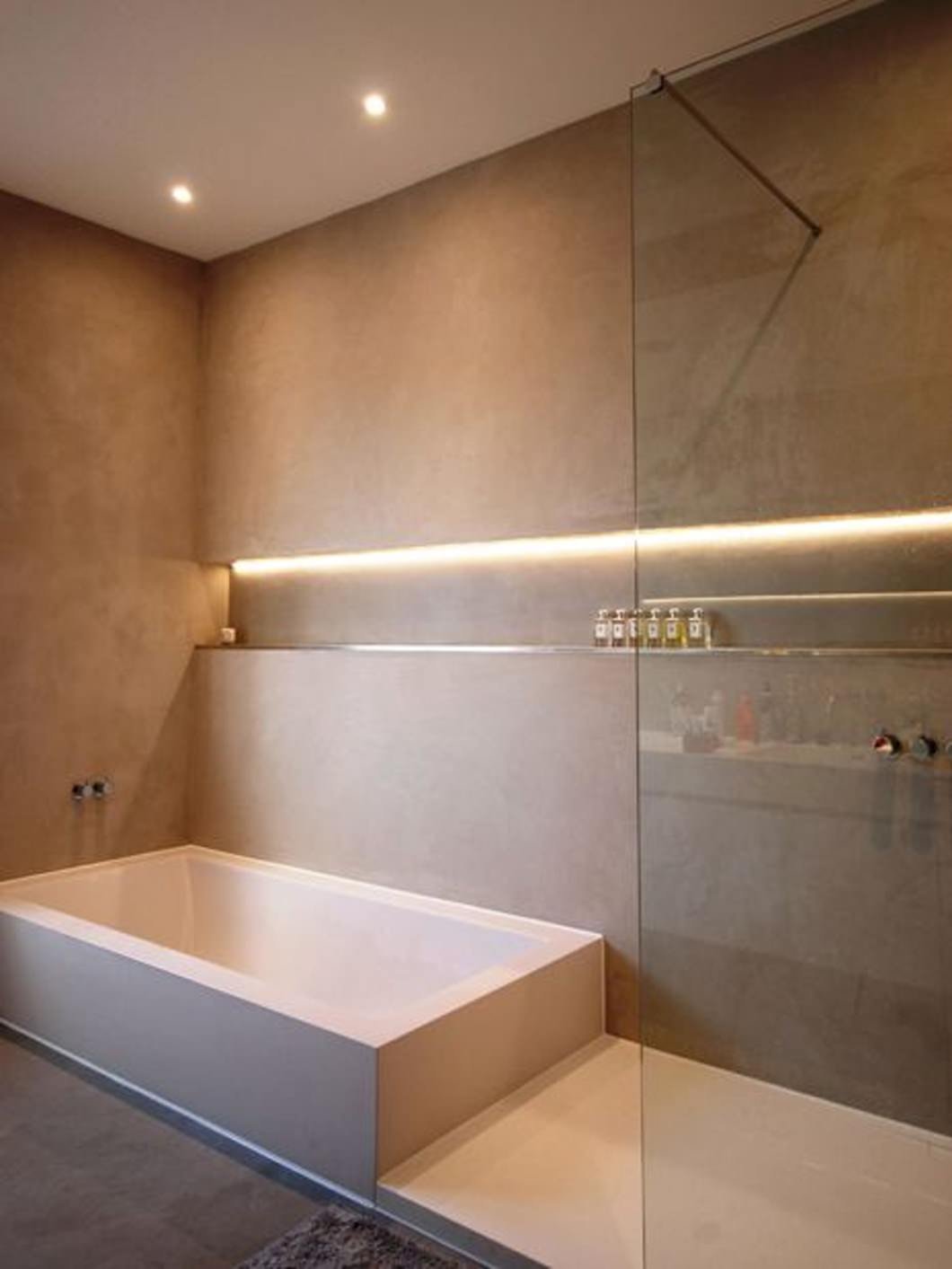 A nice example of an increasingly popular way of creating low and long niches, which follow an entire wall often above the tank. The LED light that follows its depth expands and heats the bathroom space.
A nice example of an increasingly popular way of creating low and long niches, which follow an entire wall often above the tank. The LED light that follows its depth expands and heats the bathroom space.
 A long bathroom with a bathtub-shower system, a walk-in shower followed by a bathtub positioned at the end of the room. The illuminated niche continues along the room and is also replicated in the proximity of the ceiling, to create a scenographic effect of great impact.
A long bathroom with a bathtub-shower system, a walk-in shower followed by a bathtub positioned at the end of the room. The illuminated niche continues along the room and is also replicated in the proximity of the ceiling, to create a scenographic effect of great impact.
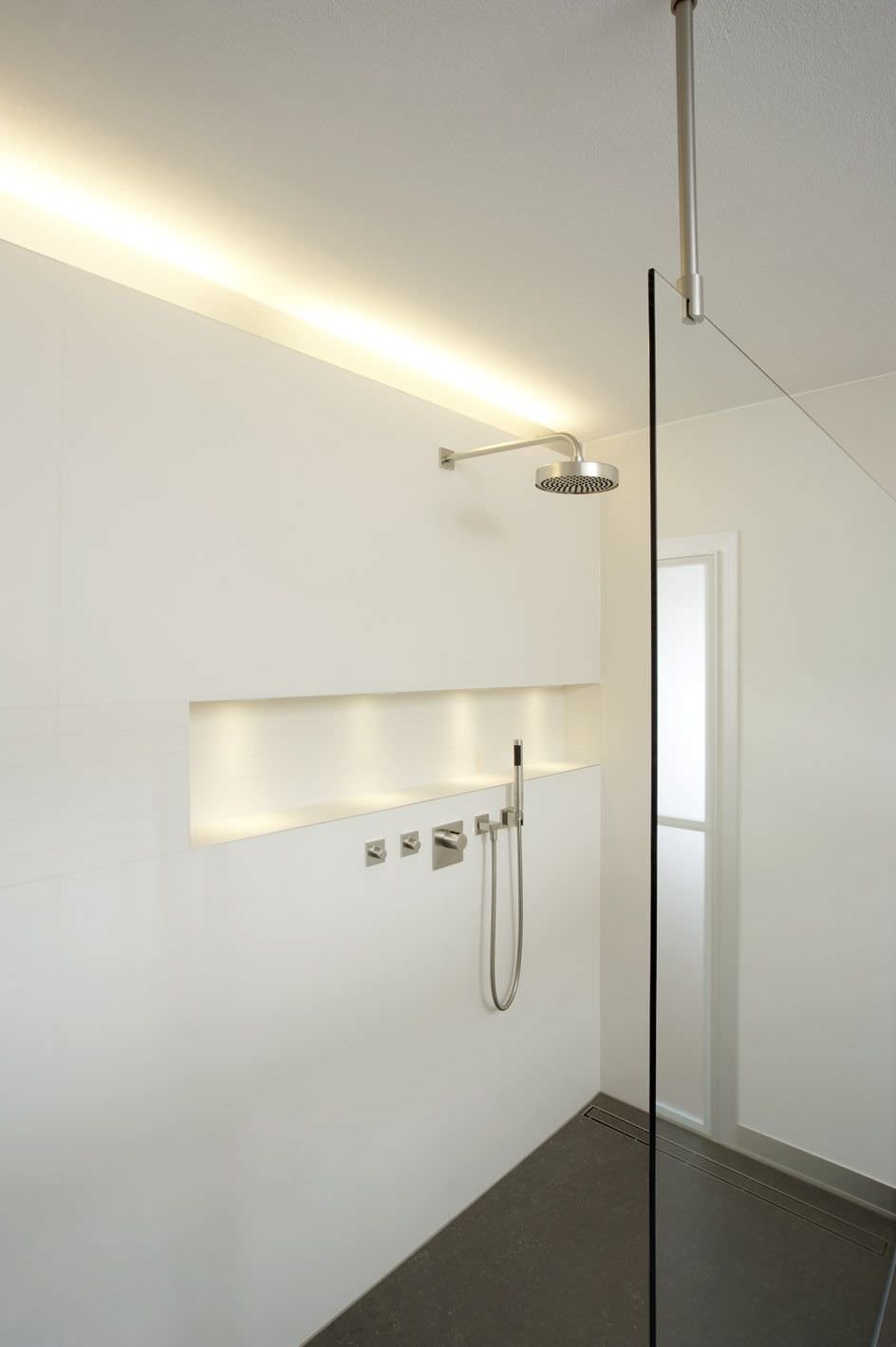 As in the previous image, the illuminated niche is also replicated in the proximity of the ceiling, on one side, to create a beautiful scenographic effect. Modern, refined and elegant style.
As in the previous image, the illuminated niche is also replicated in the proximity of the ceiling, on one side, to create a beautiful scenographic effect. Modern, refined and elegant style.
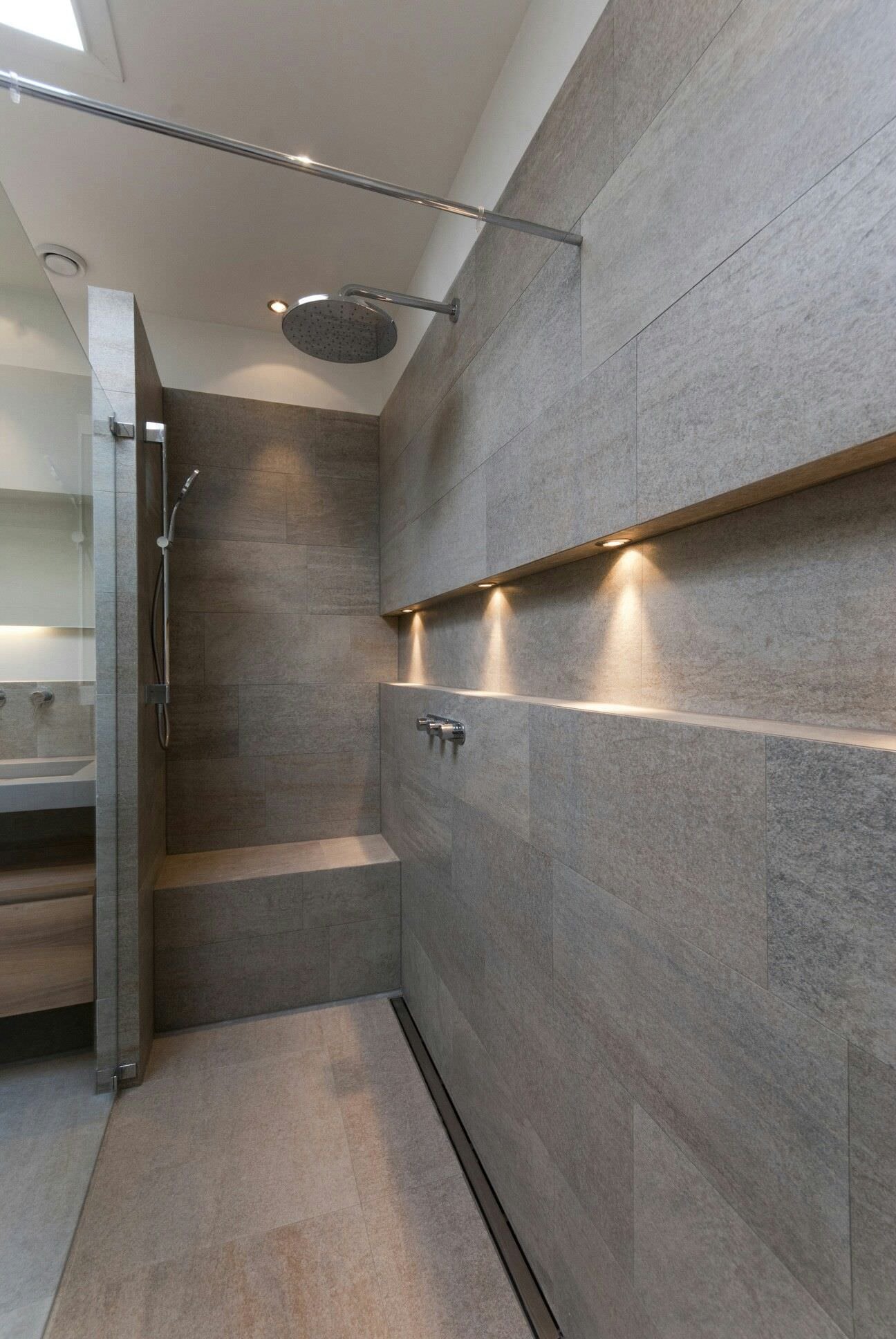

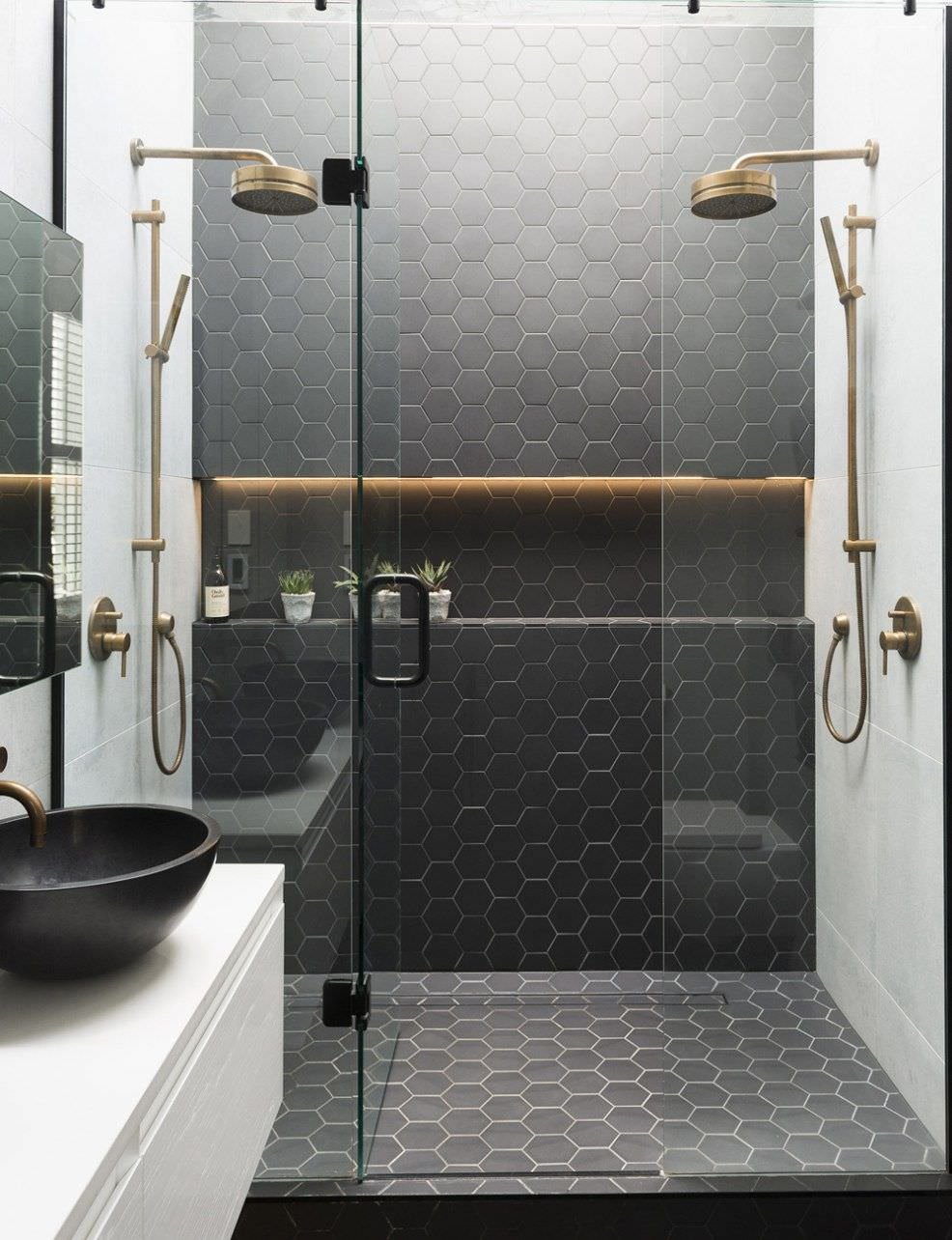
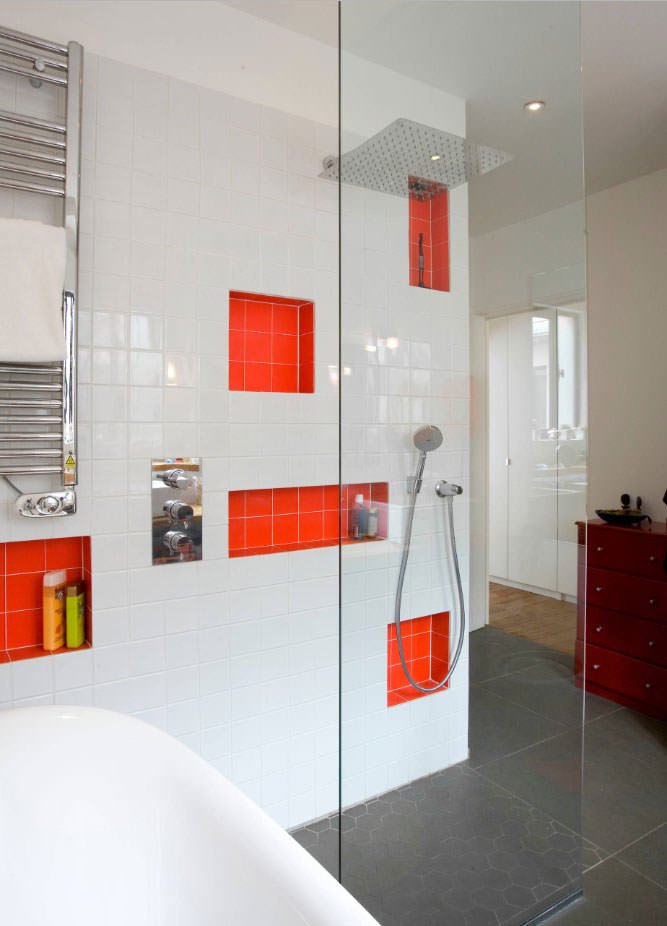
The niches are very useful in the shower to bring soaps, shampoos, razor blades, toothbrushes and more. Here a nice configuration with chromatic contrast majolica. In this way the bathroom acquires a touch of originality. Attention to detail is very important when laying the tiles.
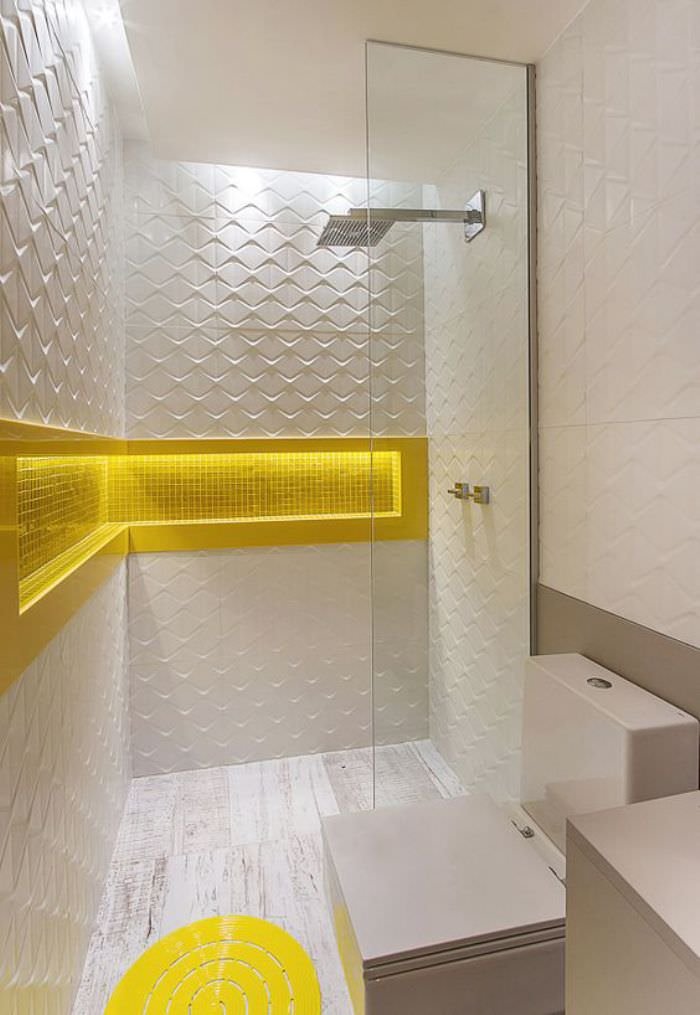 This solar-looking L-shaped niche is covered in mosaic and highlighted by a frame that makes it the focal point of the bathroom.
This solar-looking L-shaped niche is covered in mosaic and highlighted by a frame that makes it the focal point of the bathroom.
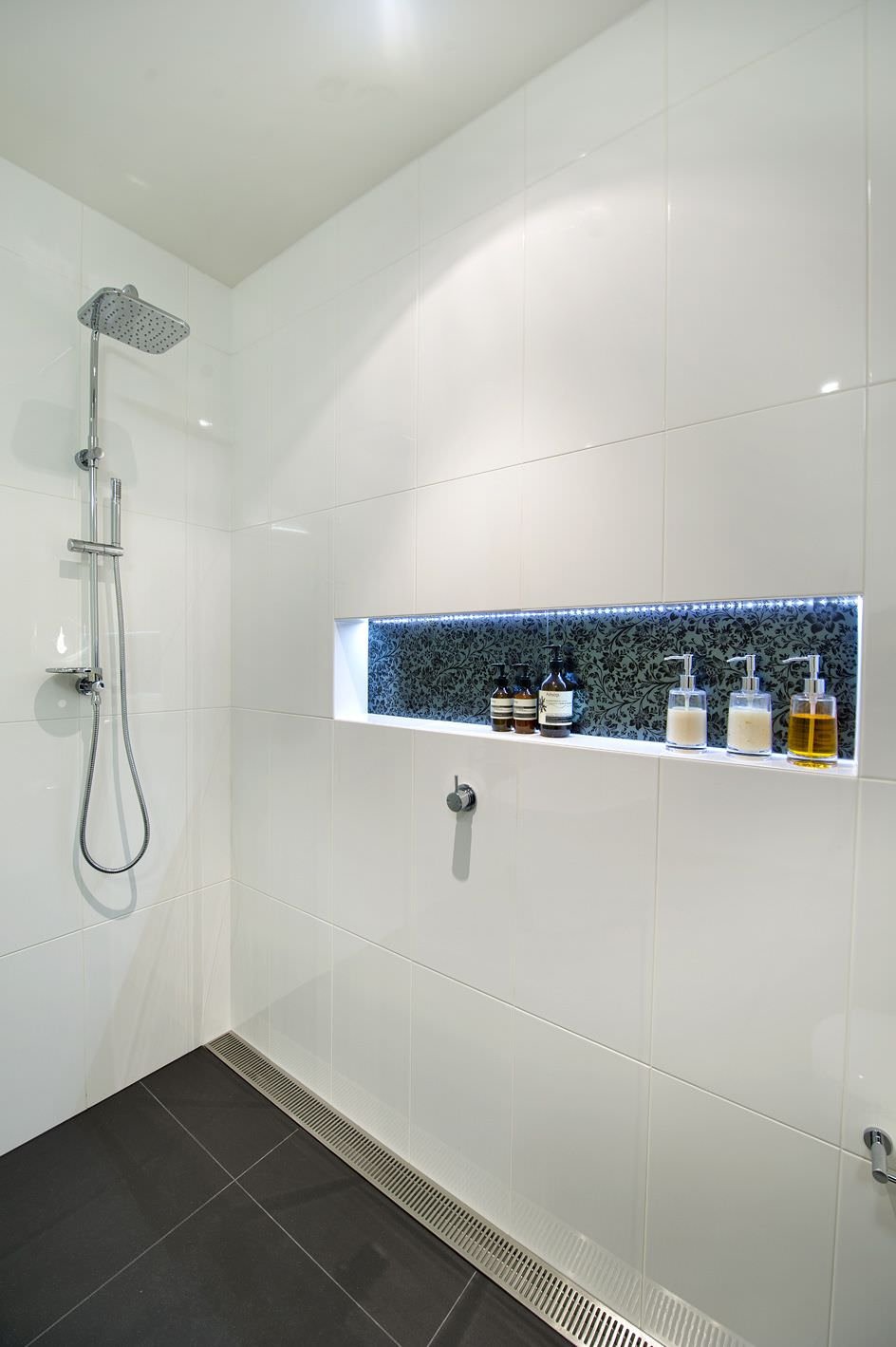 Perfectly finished shower detail, with large glossy ceramic slabs and illuminated niche covered with contrasting floral motif tiles.
Perfectly finished shower detail, with large glossy ceramic slabs and illuminated niche covered with contrasting floral motif tiles.
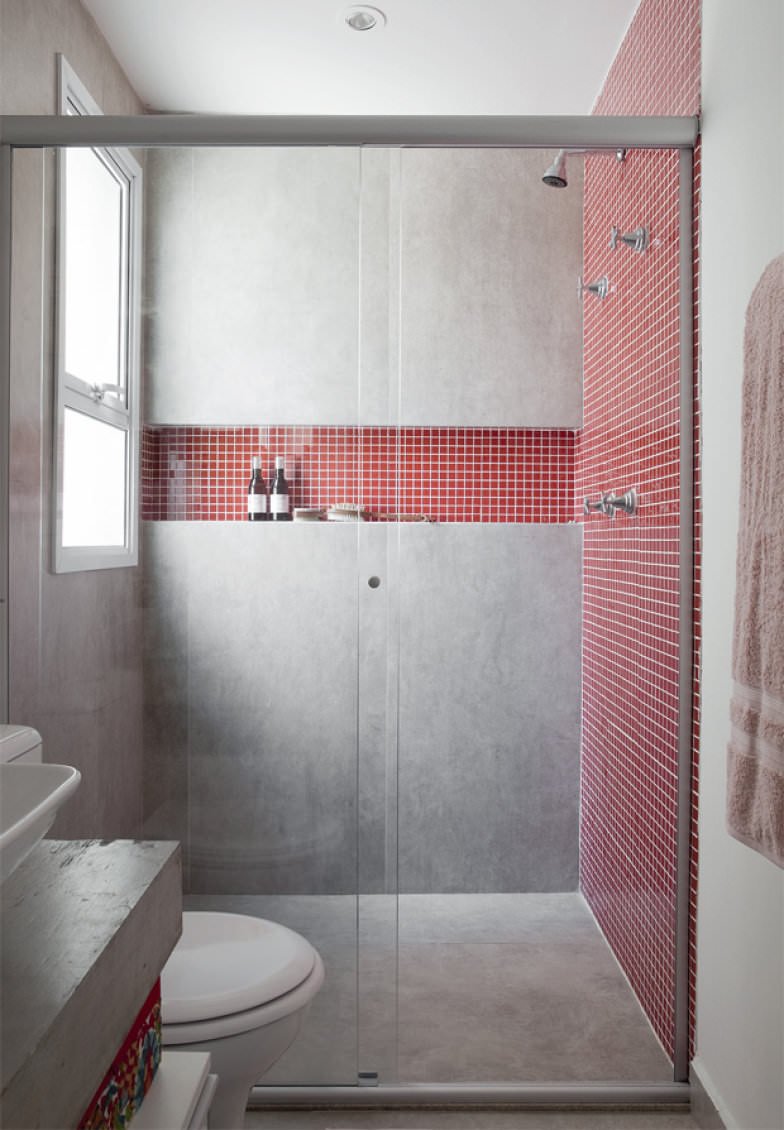
 In this small bathroom, the orange color of the niche, created above the bathroom fixtures, breaks the monochromatism of white, giving the room an original and very useful focal point. Mirror doors visually enhance the room.
In this small bathroom, the orange color of the niche, created above the bathroom fixtures, breaks the monochromatism of white, giving the room an original and very useful focal point. Mirror doors visually enhance the room.
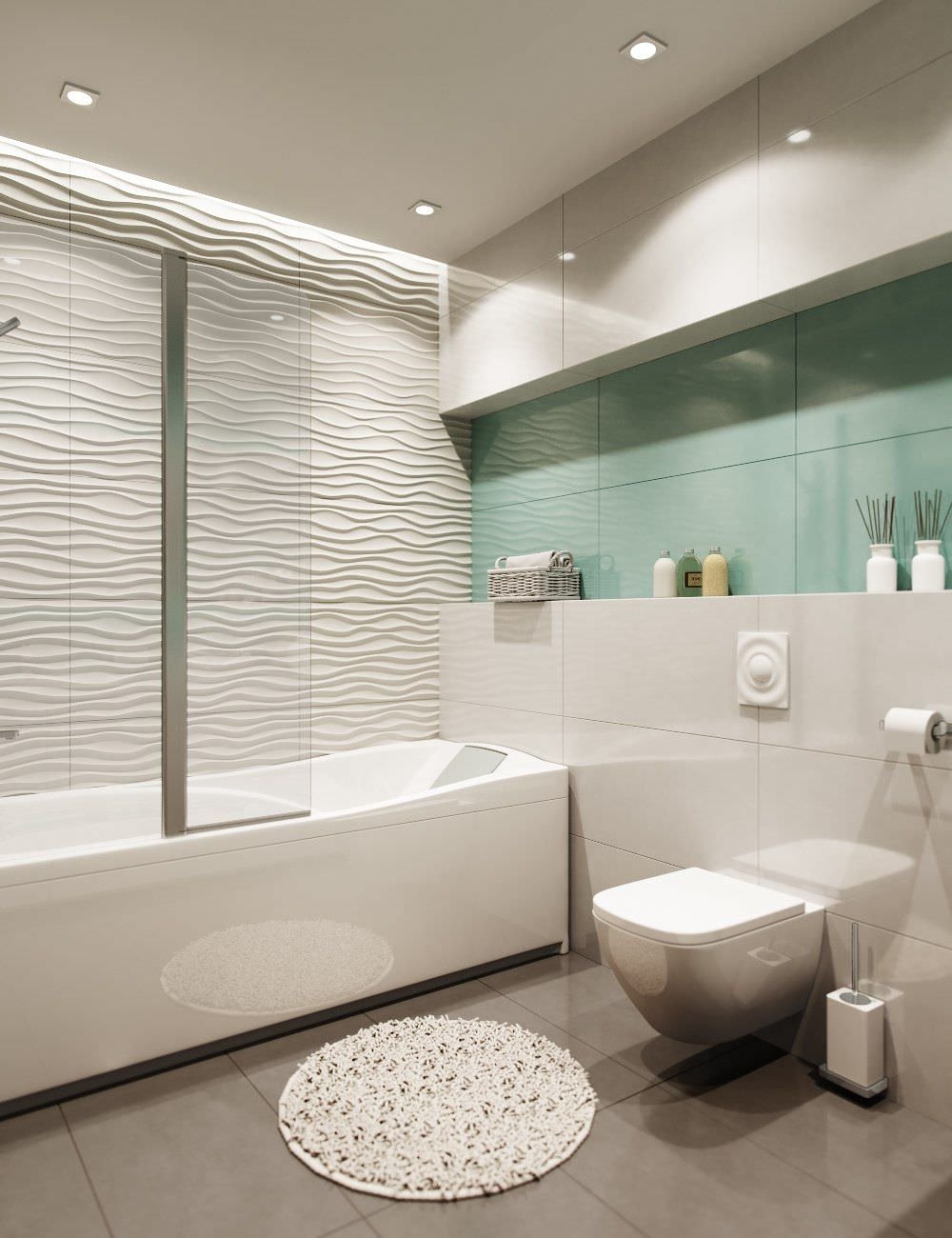
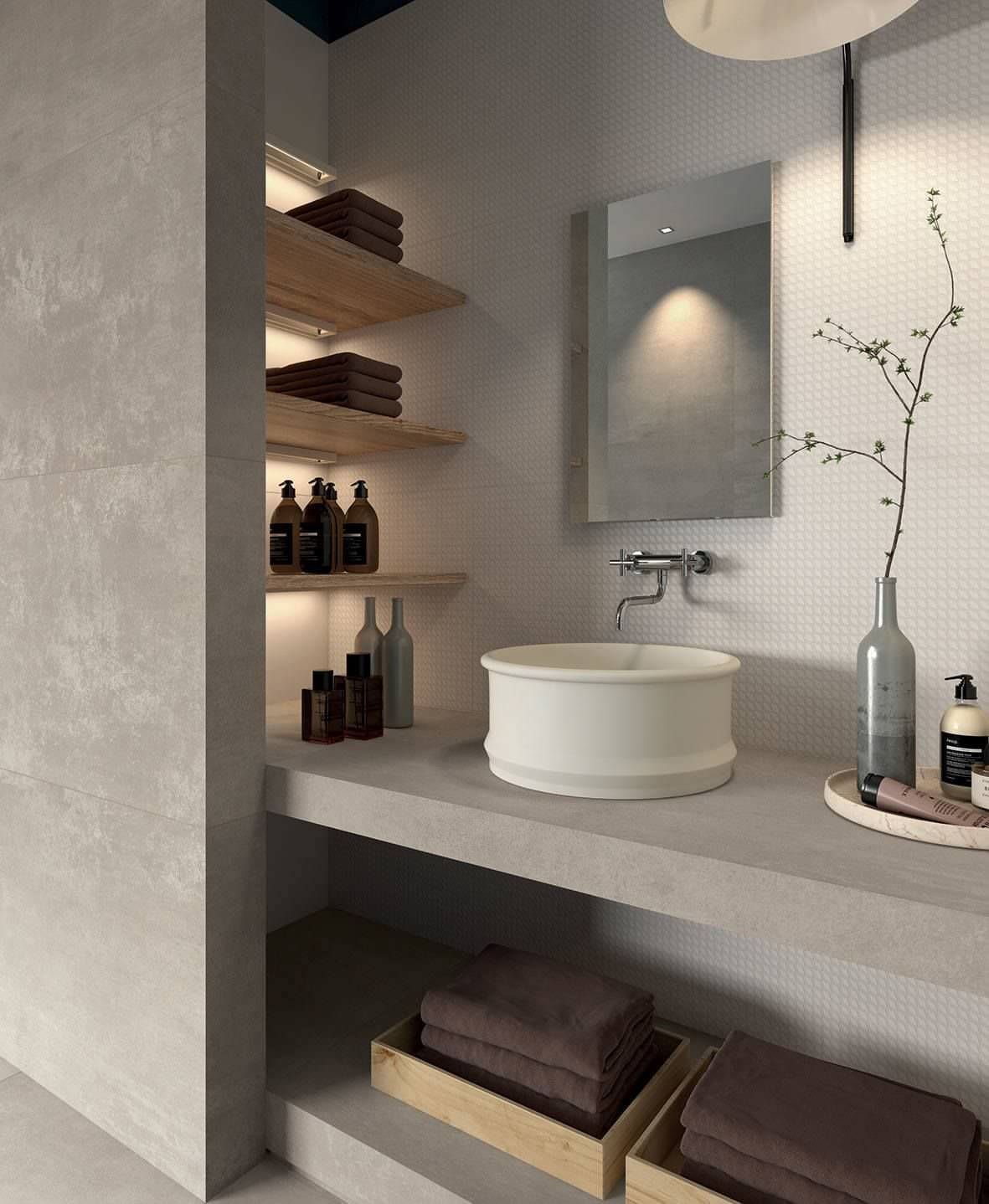 Perfect use of the niche on the side of the sink: full height, divided by wooden shelves with LED lighting.
Perfect use of the niche on the side of the sink: full height, divided by wooden shelves with LED lighting.
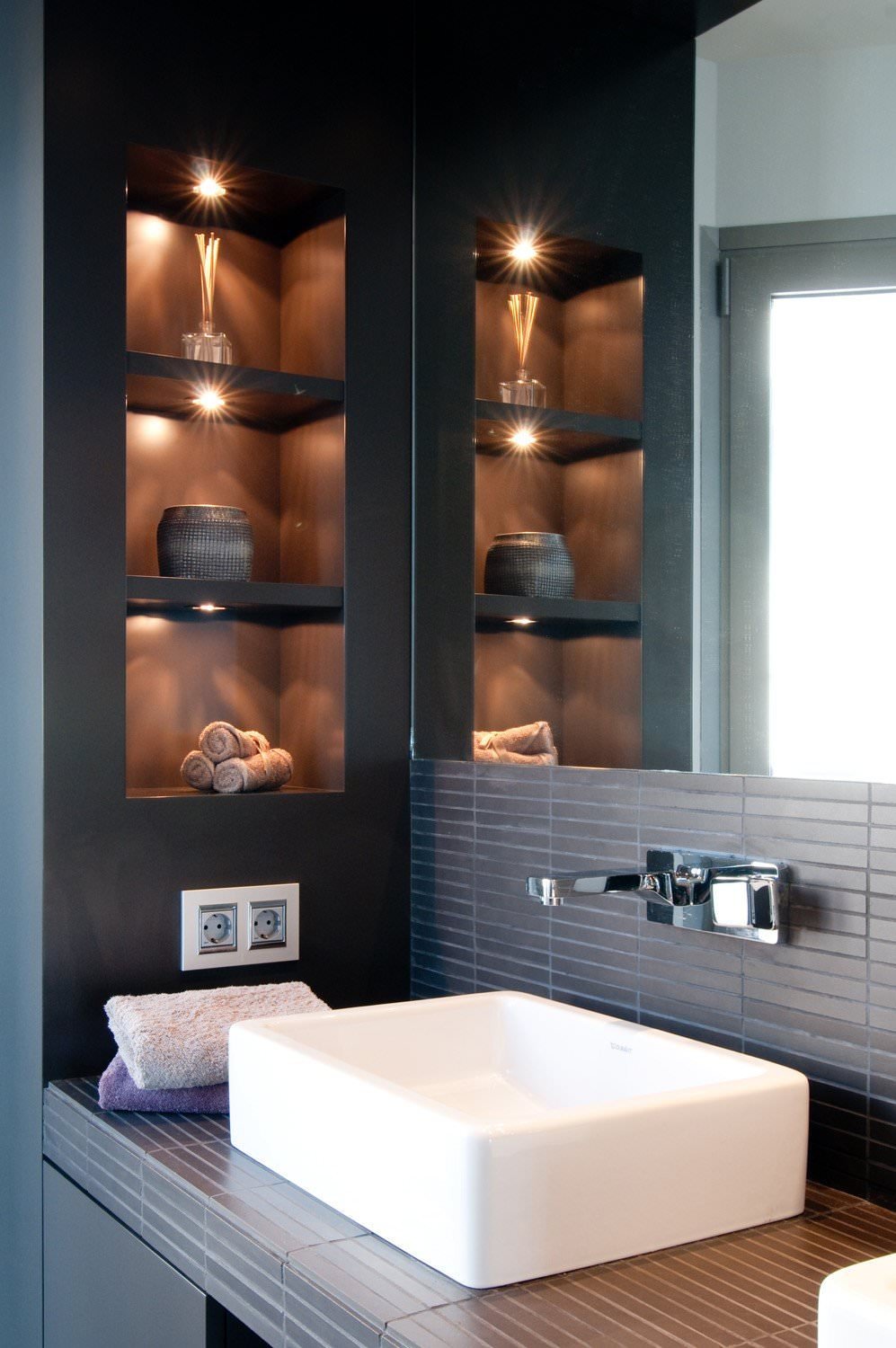 Idea similar to the previous image, with masonry bathroom and niche created on the side of the sink. Illuminated wooden platforms.
Idea similar to the previous image, with masonry bathroom and niche created on the side of the sink. Illuminated wooden platforms.
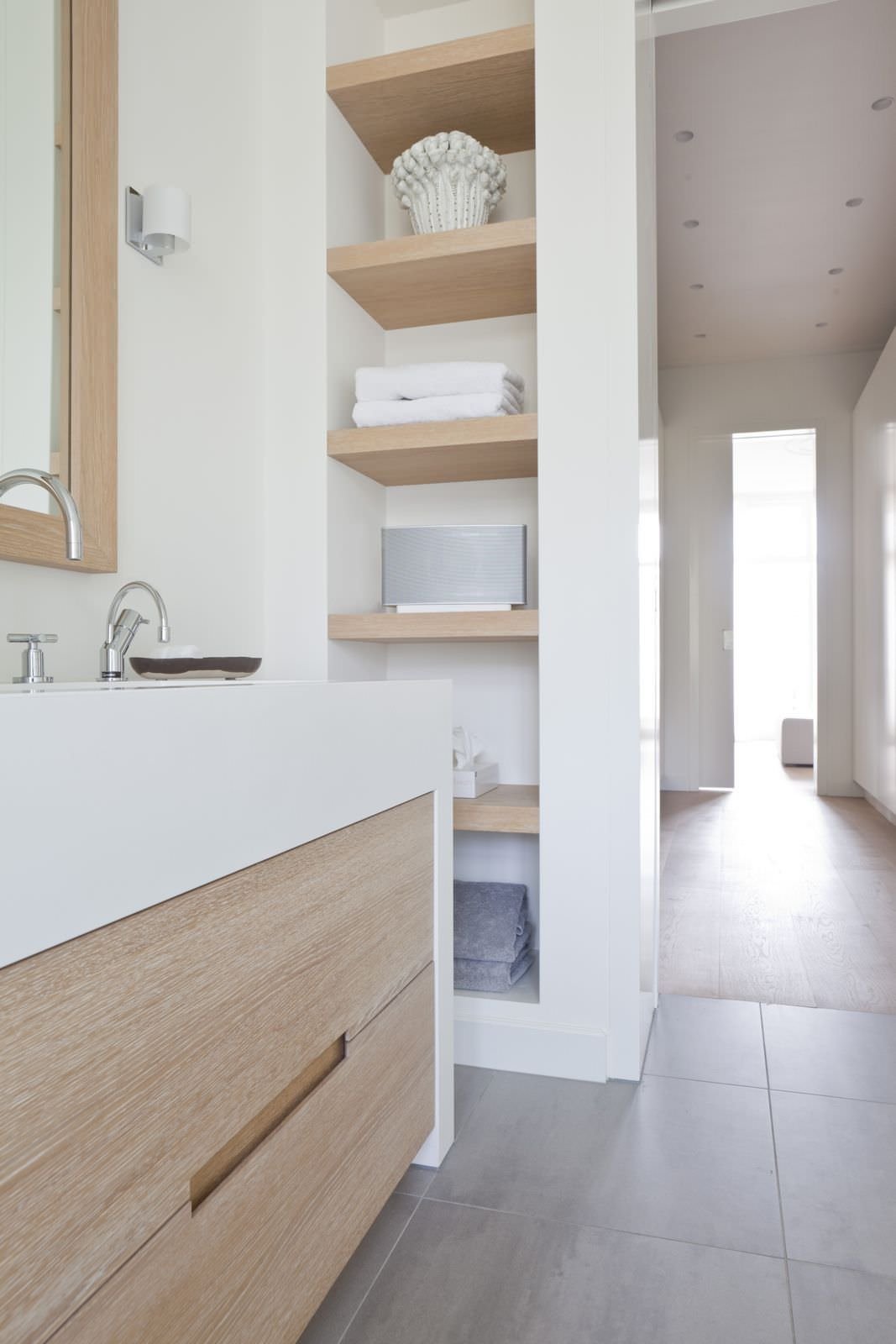
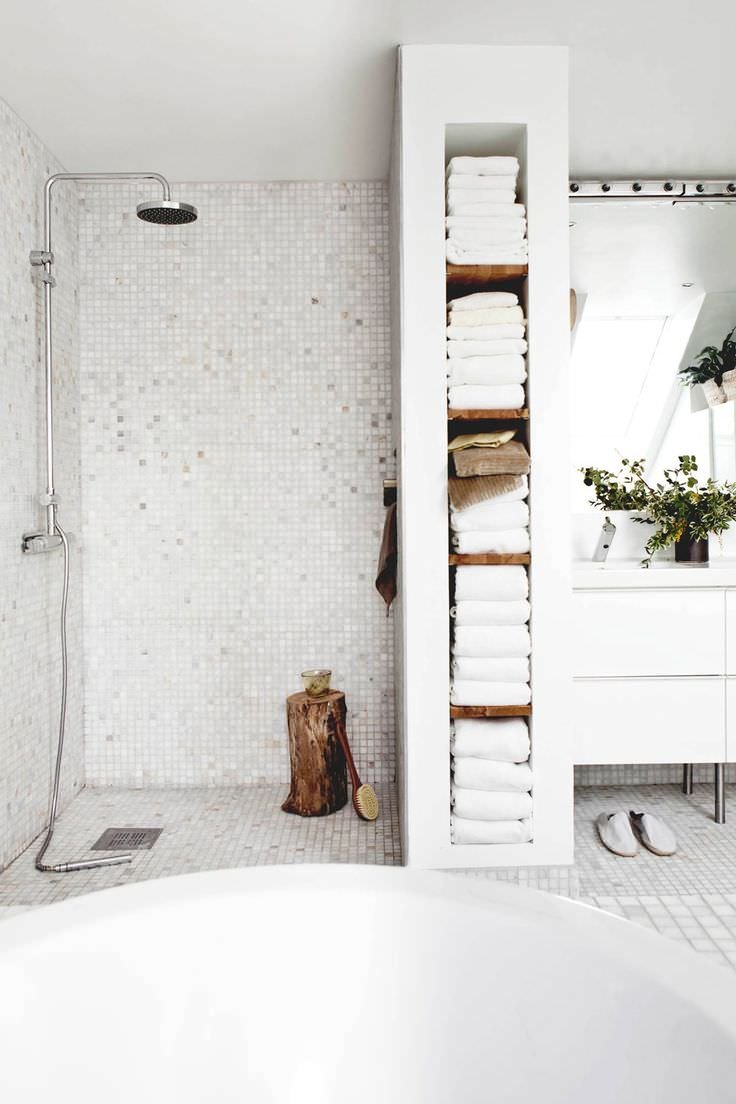 In this Scandinavian bathroom, the masonry wall that delimits the shower has been enlarged and compartmentalized to become a large wardrobe.
In this Scandinavian bathroom, the masonry wall that delimits the shower has been enlarged and compartmentalized to become a large wardrobe.
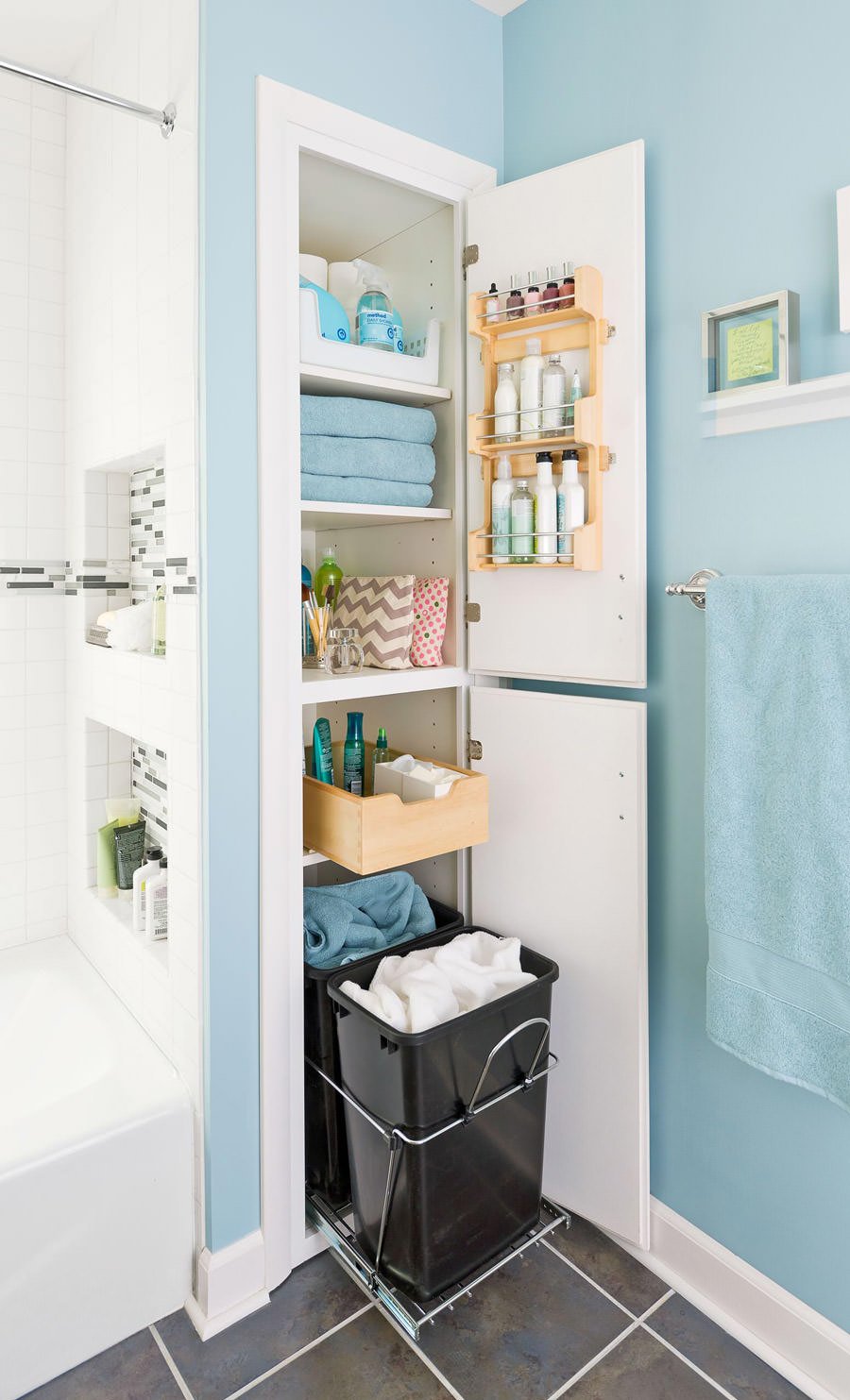 The niches can also close with doors to become real equipped wardrobes. As in this useful roof rack created from the remnant of about 50 cm between the tub and the wall.
The niches can also close with doors to become real equipped wardrobes. As in this useful roof rack created from the remnant of about 50 cm between the tub and the wall.
 Images: archdaily.com, archilovers.com, archiproducts.com, architonic.com, blankinteriors.com, insidecreation.fr, fapceramiche.com, homedsgn.com, homelook.it, homestolove.co.nz, homify.com, houzz. com, kellyhoppen.com, letiziaalessandrini.it, mamestudio.com, pinterest.com, remodelista.com, studiolivingston.com
Images: archdaily.com, archilovers.com, archiproducts.com, architonic.com, blankinteriors.com, insidecreation.fr, fapceramiche.com, homedsgn.com, homelook.it, homestolove.co.nz, homify.com, houzz. com, kellyhoppen.com, letiziaalessandrini.it, mamestudio.com, pinterest.com, remodelista.com, studiolivingston.com

Look at this bathroom with an essential design. What does your gaze fall on? Certainly the first on the niche, which with its depth contributes greatly to qualifying not only the wall, but all the bathroom space.
Why a niche in the bathroom?
The use of niches in architecture deserves a real treatise. You will all have in mind how these voids embellish small and large spaces in the history of architecture, with statues, fountains and other works of art. From churches to noble palaces, from spas to the humblest houses. The niche is a universal, practical and beautiful element. At any scale. So why not use it in your bathroom? In your raids on Pinterest you will surely have noticed how their presence attracts the eye. Very true, for the simple fact that their concavity communicates welcome, and our gaze likes the warmth of the welcome.
The bathroom is also an ideal environment for niches. Because? Because we will have many small items to fix. So many necessary objects such as creams, soaps, towels, toilet paper, brushes, razors, toothbrushes etc ... whose chaotic presence risks ruining an accurate project. Especially if you love minimal design, or if nothing else, the clean and tidy lines that prevail in modern bathrooms.
The niche is a perfect trick to hide and keep your furnishings at the same time. And if a piece of furniture occupies a certain volume, the niche, being built in, will also save you space. Here is its most basic and indispensable practical and aesthetic value.

How to make a niche in the bathroom?
As always, piercing a wall is an operation to be entrusted to a professional. Primarily for the need not to damage the systems, or to not reduce too much the section of load-bearing wall elements. The punching must also be performed in a workmanlike manner, well shaped according to the shape you prefer: with a curved back wall perhaps, or topped by an arch. This is an operation that requires the use of special and highly detailed profiles. So, unless you are well trained, once again do-it-yourself: false hope of saving that will ultimately take you more money and more time.
Obviously working on an existing element is not the only solution. If you are in love with niches, you can create them ad hoc with the help of extra plasterboard thicknesses: in this case, contact a plasterboardist .
Or, as it is easy to imagine, the solution of the niches is well suited to masonry bathrooms, where the non-load-bearing profiles abound, which can be suitably pierced to compensate for the function of the furniture. If the realization is an operation by masons or plasterboard workers, the arrangement of the niches in the space is for interior designers. As said, a void will magnetize the look: better to arrange these spaces with absolute care. Our eye, which always tends to laziness, will be more inclined to position them centrally, or according to symmetries. But often this trend will lead you to trivial, not to say unpleasant solutions. The trained eye of the interior architect will instead help you find the most unexpected and surprising locations. He will also be able to indicate the most suitable materials to make these elements perfect. Better tone on tone, or with contrasting materials? With a frame that highlights the protrusion or flush, in perfect minimal style?
The niches: shapes and light
The niches, then, must not be rectangular. Elegant arched niches refer to the traditional solution. But any geometric shape is possible: think of solutions for attic spaces, which follow the sloping profile of the pitches. Or, very impressive and increasingly adopted, very thin and horizontal niches that run along an entire wall, often above the bathtub: they constitute in themselves a decoration and will allow you to place soaps and towels.
It is also possible to close the niche with doors, like any cabinet. The possibility must be examined from case to case, but it certainly seems contradictory to hide a virtually so intriguing solution. Rather, to further multiply the space, you can create shelves in wood, or glass, on which to place all the objects. Or why not aim high and place only one sculpture in the niche? A small antique-style statue will give you the impression of a precious spa space. In any case, whatever shape they have, the niches will allow you to create a fluid environment, reducing the masses protruding from the walls. A true paradise for lovers of minimal style. As well as savings on furniture.
A very frequent pairing is with concrete masonry, given the total shapeability of this material. A spatulated concrete niche will create a very modern industrial image, with a brutalist design, which will impress you with its unique character.
In short, your bathroom deserves a precious, useful, beautiful element, which recalls tradition but which blends perfectly with modern materials.
Ideas & inspiration for niches in the bathroom // in the shower

An almost imperceptible niche, perfect in a minimal style bathroom. Simply plastered, with a slightly rounded edge, it gives the entire wall a buttery tactile consistency. A small element that transfigures the whole environment.

An important fact: the height of the niche. In this large stoneware shower, the horizontal niche is at head height, creating a particular visual effect that contains the height of the compartment.

A long and functional niche, perfectly centered with the shower mixer, covered in white resin, like the walls. Modern minimal style.

Masonry bathroom, covered in resin, with long niche made in the shower, useful and functional.

This niche, even if it is not in the "perfect" position, is a very useful space for putting soaps, bottles and small useful accessories in the shower.

Very interesting design idea for these two niches created on the sides of the vertical band, created in mosaic, which houses the shower head.


Ideas for niches in the bathroom // above the bathtub

A traditional device, but which can become an excuse for a modern design. The niche is a subtraction of matter, which qualifies the wall giving it sculptural value. The lighting creates an original and scenographic environment.

A perfect example to visually enlarge a small bathroom. The niches that run horizontally along the length of the wall with an accent of color or pattern, in addition to maximizing storage space, tend to enlarge the room.


Ideas for niches in the bathroom // above the sanitary ware








Ideas lit niches in the bathroom






Inspiration & ideas colored niches in the bathroom

The niches are very useful in the shower to bring soaps, shampoos, razor blades, toothbrushes and more. Here a nice configuration with chromatic contrast majolica. In this way the bathroom acquires a touch of originality. Attention to detail is very important when laying the tiles.





Bathroom niche ideas // closet type







